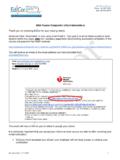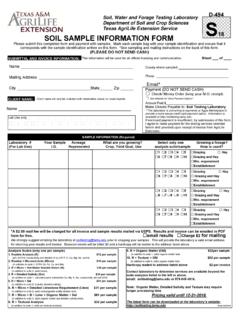Transcription of COACHING FOR ON-THE-JOB DEVELOPMENT
1 COACHING FOR ON-THE-JOB DEVELOPMENT connecticut Training and DEVELOPMENT Network October 2001 connecticut Training and DEVELOPMENT Network COACHING for ON-THE-JOB DEVELOPMENT Page 2 of 23 TRAINING PLAN FOR goals #1 & #2 TOPIC: goals #1 & #2 Define COACHING and mentoring and discern the difference between them. INSTRUCTIONS/LECTURE NOTES TIME/TRAINING AIDS Trainer may use icebreaker Trainer introduces him/herself and the lesson topic of COACHING for ON-THE-JOB DEVELOPMENT and asks if anyone has ever been a coach or been coached by someone else. Trainer will ask people who raise their hands to describe the experience and what they thought about it. Trainer will recognize the experience of the group on the topic area of COACHING by saying: I know that we all may have different levels of knowledge and experience on the topic of COACHING and I hope that you will feel free to share them with the class during this program. Trainer will give the goal and the agenda for the program by saying: The goal for the training is to teach you COACHING skills that you can use to develop other staff.
2 We will first discuss a definition of COACHING and mentoring. We will discuss the characteristics of good coaches and we will learn a COACHING model and have a chance to practice using it in class. Also, we will choose a person to coach and write an action plan to help us implement our COACHING to enhance the performance of the chosen person. 3-5 minutes 35-50 minutes Overhead Projector & Overheads (OH) Flip charts (2) and markers Handouts Overhead (OH) #1 Cover for Intro OH #2 Goal OH # 3 Agenda connecticut Training and DEVELOPMENT Network COACHING for ON-THE-JOB DEVELOPMENT Page 3 of 23 INSTRUCTIONS/LECTURE NOTES TIME/TRAINING AIDS Trainer will give the objectives for the class: After the program, participants will be able to: 1. Define COACHING , mentoring and the difference between them 2. List characteristics of good coaches 3. State the benefits of COACHING 4. Demonstrate good COACHING skills 5. Identify a person to coach 6.
3 Write an action plan to coach the chosen person Trainer will assign Activity # 1 giving the participants/ groups 10 minutes to complete. Trainer will discuss the answers to the first 2 questions and tell class that their answers are basically the same as the definitions we will be using to define COACHING and mentoring. Trainer will give the definition: COACHING is the process used to empower individual employees to put forth their best efforts. (Infoline, 1990) Trainer will give the class the definition of mentoring: Mentoring is a process of lifelong guidance that assists people in attaining achievement in their respective organizations and careers. (State Training Network, 2001) Trainer will ask the class how COACHING is different from mentoring and emphasize that COACHING is used to enhance immediate performance enhancement while mentoring is used to help people attain their full potential for a long time. OH # 4 Objectives Activity # 1 Overheads # 5 & 6 COACHING & Mentoring Defined connecticut Training and DEVELOPMENT Network COACHING for ON-THE-JOB DEVELOPMENT Page 4 of 23 INSTRUCTIONS/LECTURE NOTES TIME/TRAINING AIDS Trainer will then ask the class to do Activity # 2-(either individually or in small groups) and the entire group.
4 Characteristics of a Coach: Participants need to think of a person who was a good coach or teacher for them and list the characteristics that made him/her effective as a coach. The trainer should give the class about 10 minutes and ask them to report back to class what they listed.(Trainer can list on FC or have each group do a flip chart to present back to group) Trainer will tell the group that the characteristics they have listed are utilized by coaches in the 7-Step COACHING Model, which they will be learning to use in this program. Trainer will make a bridge to the next module on the Benefits of COACHING . Use Activity # 2 Flip chart # 1(FC) connecticut Training and DEVELOPMENT Network COACHING for ON-THE-JOB DEVELOPMENT Page 5 of 23 Activity #1 for Objective #1 In your groups, answer the following: Define COACHING : Define Mentoring Is there a difference between COACHING and mentoring?
5 If so, what is the difference? connecticut Training and DEVELOPMENT Network COACHING for ON-THE-JOB DEVELOPMENT Page 6 of 23 Activity #2 for Objective #2 Think back to a person who influenced you, motivated you, believed in you and coached you to do better than you thought you could ever do. List the characteristics which made him/her an effective coach. 1. 2. 3. 4. 5. 6. 7. 8. 9. 10. connecticut Training and DEVELOPMENT Network COACHING for ON-THE-JOB DEVELOPMENT Page 7 of 23 TRAINING PLAN FOR GOAL #3 TOPIC: Goal #3 State the benefits of COACHING . INSTRUCTIONS/LECTURE NOTES TIME/TRAINING AIDS INTRODUCE COURSE MODULE: The Benefits Of COACHING ACTIVITY: Out-of-the-Classroom Scavenger Hunt Divide learners into pairs or small teams. Ask them to go out into the organization and seek out as many answers as possible to the question, What are the benefits of COACHING ? Give learners hints about where they can go to find the answers (managers, supervisors, colleagues, subordinates).
6 Give learners a specified time to collect their answers and get back to class. When all have returned, lead a debriefing of what learners have discovered. Ask for a volunteer to construct a collective list of benefits on flipchart paper. Add anything you think is necessary to the list that learners may have omitted. Optional: Award small prizes to the team who brings back the most number of benefits; and runner-up prizes for all others. 25-60 minutes o Pads of paper o Pens o Small prizes (optional) connecticut Training and DEVELOPMENT Network COACHING for ON-THE-JOB DEVELOPMENT Page 8 of 23 INSTRUCTIONS/LECTURE NOTES TIME/TRAINING AIDS ACTIVITY: Brainstorming Session with Group on Benefits of COACHING Ask group what they think the benefits are for COACHING Facilitate discussion by asking: 1. What are the benefits for the employee, the person being coached? (Sample responses: improves skills, enhances self esteem) 2. What are the benefits for you as the coach?
7 (Sample responses: learn new way of improving performance, shows that you care about staff) 3. What are the benefits for the organization? (Sample responses: happier employees, better performance, less conflict in workplace) Write responses for each category above on flipchart Summarize answers, noting that being a skilled coach benefits everyone Recognize and thank participants for their contributions 10-15 minutes Flip chart and paper Markers connecticut Training and DEVELOPMENT Network COACHING for ON-THE-JOB DEVELOPMENT Page 9 of 23 TRAINING PLAN FOR GOAL #4 TOPIC: Goal #4 Demonstrate good COACHING skills. INSTRUCTIONS/LECTURE NOTES TIME/TRAINING AIDS INTRODUCE COURSE MODULE: 7-Step COACHING Model for Good COACHING Skills ACTIVITY: 7-Step COACHING Model Divide the class into 8 small groups. Distribute the 7-Step COACHING Model Handout and assign a Step to each small group. Assign the foundation for all steps to the eighth group.
8 Tell groups they have 15 minutes to develop a 5-minute presentation for the entire class about their assigned Step. Request groups to present their lessons , beginning with the foundation, and moving through Steps 1-7. Add your own comments to each presentation as necessary. 60 minutes o 7-Step COACHING Model Handout (see Exhibit A at end of this document) o Flipchart Paper o Markers o Masking Tape connecticut Training and DEVELOPMENT Network COACHING for ON-THE-JOB DEVELOPMENT Page 10 of 23 INSTRUCTIONS/LECTURE NOTES TIME/TRAINING AIDS ACTIVITY: Collaborative Role Play Develop one scenario with 7 parts that relates to each of the 7 steps in the COACHING model. Write the scenario on large index cards, putting each part of the scenario that relates to a different step onto a different index card. Make 4 complete sets of index cards. Recruit two learners to play the role of the coach and two learners to play the role of the coachee (person being coached).
9 Introduce the first-step scenario by distributing the appropriate set of index cards to the four role players. Ask each pair to alternate who actually does the speaking. Tell pairs that they will have 15 seconds to confer with each other before making each response. {Optional: Recruit a timekeeper.} Post the guidelines for being supportive in front of the classroom and remind learners about the foundation for each Step. Start the role-play. Debrief, as appropriate. Continue recruiting volunteers and introducing the next step in the scenario until all of the 7 steps in the COACHING model has been addressed with a role-play. Debrief, as appropriate, at the conclusion of each part of the scenario. 60 minutes o Props, as appropriate, such as signs that say Coach and Person Being Coached Sets of large index cards connecticut Training and DEVELOPMENT Network COACHING for ON-THE-JOB DEVELOPMENT Page 11 of 23 BE SUPPORTIVE #6 Clarify Consequences; Don t Punish #2 Identify Reasons for Change and DEVELOPMENT #7 Don t Give Up #5 Confront Excuses/ Resistance #4 Get a Commitment #3 Initiate a Plan #1 Discuss Issues And Expectations 7-Step COACHING Model connecticut Training and DEVELOPMENT Network COACHING for ON-THE-JOB DEVELOPMENT Page 12 of 23 7-Step COACHING Model The Foundation for All Steps: Be Supportive Supportiveness is not an option when it comes to COACHING .
10 It is a MUST. Being supportive is the keystone of the 7-step COACHING model. It must occur during each phase. Research shows that the more supportive the coach is, the more successful the change. How does a coach show support? The 10 behaviors exhibited by the most successful coaches are as follows: 1. Collaboration/Flexibility Responsibility is mutually shared for assignments, tasks, and changes, with a willingness to compromise and work together. 2. Helping/Assisting Coach is willing to help out, provide resources, and be available for future consultation. 3. Empathy/Understanding Coach treats the employee s feelings, concerns, obstacles, and difficulties with dignity. 4. Recognition Of Employee s Value Coach expresses appreciation, believes the employee is an important part of the team, and gives the employee a positive sense of self-esteem. 5. Listening/Interaction Willing to give the employee full attention, the coach asks lots of questions and gives the employee time to express ideas, reactions and suggestions.
















